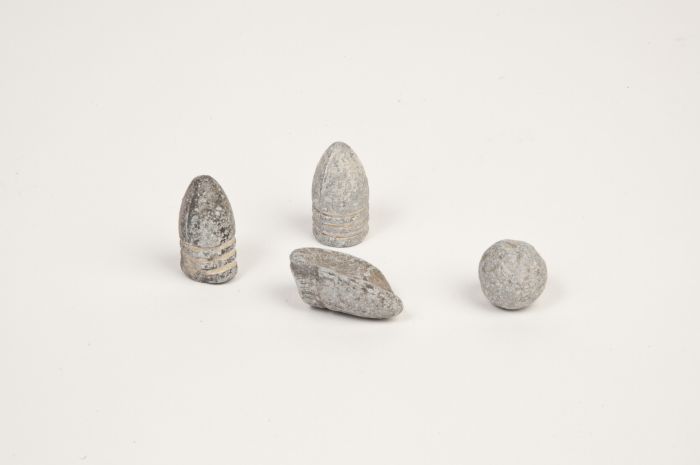5
United States Surgeon-General's Office, Consolidated statement of gunshot wounds, 1863
From the collections of the Boston Medical Library
John Hill Brinton (1832-1907), a surgeon with the United States Volunteers, compiled statistical information on gunshot wounds and amputations from reports submitted by the army hospitals to the Surgeon General’s Office. Table no. 4 lists over 1,300 amputations performed during the months of September through December, 1862. The Medical and Surgical History of the War of the Rebellion (1870-1888), produced by the Surgeon-General’s office, records nearly 30,000 Union soldiers undergoing amputations, with nearly 22,000 surviving.
Minie and other lead balls from the American Civil War, 1860-1862.
Lead
Donated by the Adams Family, 1982
Warren Anatomical Museum, Francis A. Countway Library of Medicine [WAM L017.001.1982]
Zabdiel Boylston Adams collected these bullets in 1862 from a Civil War battlefield.
Distal end of left femur with fracture and lead ball embedded in lateral condyle, 1860-1865
Bone; brass; wood
Donated by Jeffries Wyman, M.D., 1874
Warren Anatomical Museum, Francis A. Countway Library of Medicine [WAM 06692]
The preparation was originally collected and mounted by the Army Medical Museum in Washington, D.C., most likely number 460. In the 1863 published catalogue of the Army Medical Museum, 460 is listed as "gunshot fracture of the Femur" that was collected and donated by Assistant Surgeon William Moss of the United States Volunteers. It was transferred from the Army Medical Museum to Jeffries Wyman between 1863 and 1874 and formerly resided in his museum. At his death in 1874 Wyman left the preparation to the Boston Society for Natural History which then transferred it to the Warren Anatomical Museum.
Distal portion of right femur with embedded ball, 1860-1865
Bone; brass; wood
Donated by Jeffries Wyman, M.D., 1874
Warren Anatomical Museum, Francis A. Countway Library of Medicine [WAM 06693]
This fractured partial right femur is from an unknown solider of the American Civil War. The preparation was originally collected and mounted by the Army Medical Museum in Washington, D.C. It was transferred to Jeffries Wyman between 1860 and 1874 and formerly resided in his museum. At his death in 1874 Wyman left the preparation to the Boston Society for Natural History which then transferred it to the Warren Anatomical Museum.
Scapula, showing a well-defined circular rifle ball perforation, 1863
Bone; brass; wood
Donated by John W. Foye. M.D., 1863
Warren Anatomical Museum, Francis A. Countway Library of Medicine [WAM 00984]
This scapula was found or removed from an unidentified soldier injured on a Virginia battlefield in 1863. The donor, John W. Foye, was a graduate of Harvard Medical School and served as a surgeon in the Eleventh Massachusetts Infantry.
Cranium fragment with embedded ball, 1860-1865
Bone; metal; wood
Physician and donor unknown
Warren Anatomical Museum, Francis A. Countway Library of Medicine [WAM 04973]
This cranium fragment is from a solider of the American Civil War. He exhibited no symptoms after injury. The wound developed into a brain abscess and the soldier died 3 weeks after being shot.
Eight and a half inches of humerus, removed at the shoulder after fracture, 1870
Bone; brass; wood
Amputated and donated by John Homans, M.D., 1870
Warren Anatomical Museum, Francis A. Countway Library of Medicine [WAM 03679]
This section of amputated humerus was from a 65 year old Union artillerist. In 1864 his hand was severely injured by a premature cannon discharge and amputated at the wrist joint. John Homans performed four subsequent amputations, dissected the nerves out of the stump, and administered subcutaneous morphine injections to lessen the soldier’s constant pain. This pain originated not in the remaining limb but from the patient’s absent hand and fingers. A year after the first amputation, the humerus was fractured, after which a small pulsating tumor was found below the clavicle. Homans thought the tumor an aneurysm and possibly the source of the pain. He removed the remaining stump and twenty ligatures were required to close the wounds. The aneurysm gradually reduced in size and pulsation.
Portion of a fractured comminuted right femur, 1860-1865
Bone; brass; wood
Donated by Jeffries Wyman, M.D., 1874
Warren Anatomical Museum, Francis A. Countway Library of Medicine [WAM 06691]
This fractured partial right femur is from an unknown solider of the American Civil War. The preparation was originally collected and mounted by the Army Medical Museum in Washington, D.C. It was transferred to Jeffries Wyman between 1860 and 1874 and formerly resided in his museum. At his death in 1874 Wyman left the preparation to the Boston Society for Natural History which then transferred it to the Warren Anatomical Museum.









